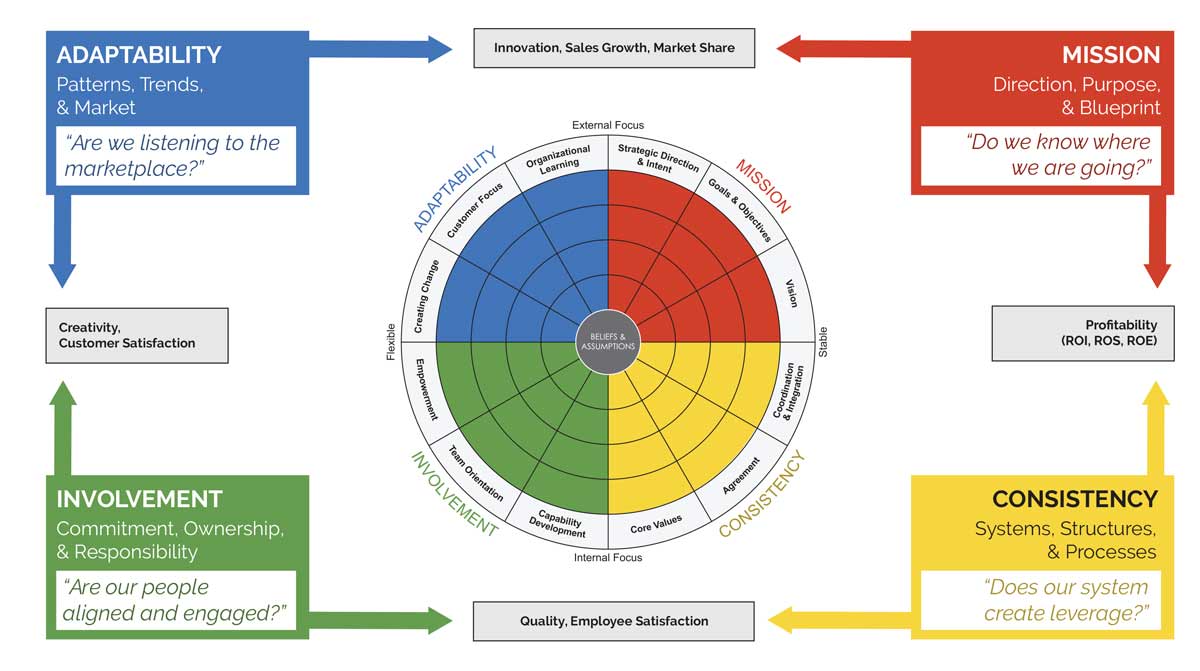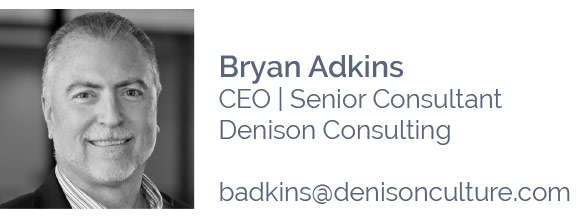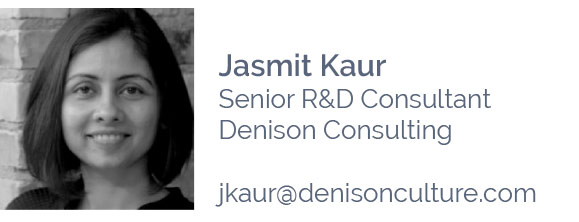100 Actions: What Organizations Do to Build a High-Performance Culture
By Bryan Adkins Ed.D., CEO, Denison Consulting
and Jasmit Kaur, Senior R&D Consultant, Denison Consulting
and Jasmit Kaur, Senior R&D Consultant, Denison Consulting
At Denison Consulting, we have spent the last two decades conducting research and working with organizations from across the globe to determine the impact that culture has on business performance. As a result of that work, we are often asked: What actions do organizations take to improve their culture? This document shows a sampling of 100 different actions from over 100 organizations. These actions are tied to various aspects of organizational culture that our research and practice has shown can elevate performance, and improve the level of clarity and alignment in organizations regarding what they do, why they do it, and how they do it.
Some Context on 100 Actions
A strong focus has emerged to inform the conceptualization and measurement of organizational cultures (or, in practice-terms, the “diagnosis”). The ability to measure organizational culture continues to evolve as we learn how to integrate and take full advantage of employee listening, pulse surveys, and predictive models. Experience tells us that a robust diagnosis is necessary in order for companies to focus their energy and resources on the areas of culture that impact performance. It is important to remember that the impact ultimately depends on what the organization does with the diagnostic insights gained. Insight is good. Insight put into action is even better.
There are times when a diagnosis points us in a very clear direction and the actions needed are rather obvious. However, this is rarely true for culture work in organizations. Culture is complex, systemic, and can manifest itself in a variety of different behaviors and practices, so the number of possible actions and the ways in which to go about implementing and measuring their impact are immense.

Of course, regardless of the complexity, this doesn’t stop clients from asking for “silver bullet” solutions to various problems. It is the lure of the “best practice.” What is that “one thing” we can do to improve our culture and performance? We caution clients against simply selecting from a set of best practices and trying to implement them, as individual activities run the risk of creating a Frankenstein monster (a creature stitched together). The result can be an awkward, clumsy set of activities that result in frustration or even cynicism regarding culture and the culture development effort.
There is much that can be learned from the successes and failures of others. Being clear about the culture you are trying to create and developing a coherent set of behaviors and practices that reinforce that culture is important. And yes, adapting (vs. simply adopting) some “tried and true” practices and contextualizing them in accordance with the desired culture can minimize the risk of “re-creating the wheel” and inspire confidence that change can be achieved, and achieved successfully.
Based on our collective consulting experience working with clients across various industries and geographies, think of these 100 Actions as “tried and true” practices that you may be able to adapt to your desired culture and, equally important, use as a source of inspiration.
We always say that culture diagnosis should do 3 things: start honest conversations that lead to thoughtful actions and improved performance, use these actions to encourage creativity, and foster excitement about what might work in your organization.
100 Actions Across the
Denison Model
Denison Model
This document shows a sampling of 100 different actions tied to various organizational culture issues. To facilitate navigation across these 100 Actions, each action is linked to a corresponding “index” from the Denison Organizational Culture Model, the culture framework that is at the core of our culture transformation work.

About the Model: The Denison Model of Organizational Culture highlights four key traits that an organization should master in order to be effective:
MISSION: Do we know where we are going?
ADAPTABILITY: Are we responding to the marketplace/external environment?
INVOLVEMENT: Are our people aligned and engaged?
CONSISTENCY: Do we have the values, systems, and processes in place to create leverage?
At the center of the model are the organization’s “Beliefs and Assumptions.” These are deeply held aspects of an organization’s identity that are often hard to access but create the culture. The four traits of the Denison Model measure the behaviors driven by these beliefs and assumptions.
Each trait is broken down into three indexes. For example, Adaptability breaks down into Creating Change, Customer Focus, and Organization Learning.

1. Ask every leader to create a 1-pager for their team that includes the Company Mission, Vision, and Values, and includes the team’s goals—connecting them to the bigger picture.
2. Adopt Denison’s Create-Communicate-Clarify-Reinforce model to ensure that Vision and Strategy move beyond the communication stage to enhanced ownership, with a clear demonstration of how they impact decisions.
3. After merging two companies, develop a strategic roadmap for “winning” in the marketplace, highlighting growth, productivity and accountability.
4. Clarify and communicate five strategic priorities after conducting a needs assessment with customers—priorities that help connect the internal actions to the customer wants and needs.
5. Hold “what-how-and-why” town hall meetings to build employees’ understanding of the company direction. Allow employees to ask questions and gain greater clarity about the priorities and direction and how they affect their work.
6. Hold CEO-led strategy workshops, bringing all managers together to discuss and understand each division’s strategy and goals, and how they align to support the company vision and strategy.
7. Create “strategic thinking” councils to engage staff in dialog about institutional priorities and future opportunities.
8. Initiate a long-range strategic planning process, in collaboration with the board of directors, that includes a SWOT analysis and engages leaders from across the organization.

9. Create a set of clear behavioral objectives that reinforces how work needs to get done in order to support shifts in the strategy.
10. Increase the frequency (and methods) of communicating key metrics related to quality, safety, efficiency, and waste-reduction.
11. Implement the use of scorecards to increase transparency and accountability regarding critical KPIs.
12. Utilize a specific framework for goal setting (SMART – Specific, Measurable, Achievable, Realistic and Timely).
13. Give a quarterly award for teams and individuals based on measurable contributions to goals.
14. Adopt a performance management process that includes feedback and dialogue about progress towards individual and team goals.
15. Adopt several “big picture” goals that promote cross-functional coordination in order to achieve those goals.
16. Open meetings with progress updates on team goals to keep them top-of-mind and relevant.

17. Start important meetings with a reminder of the Vision of the Company and why it is important.
18. Hold intensive 2-day “leadership summits” to gain understanding and buy-in to the vision and values, with the expectation that leaders at all levels communicate the vision and values frequently and consistently.
19. Use social media and internal communication vehicles to highlight examples of the company, demonstrating the mission and vision.
20. Make the mission and vision key components of your employee onboarding process.
21. Have the CEO conduct “roadshows” to get out and create more clarity and excitement about the vision, including stories of success and progress.
22. Have the CEO demonstrate his/her own passion about the work of the company, including a personal message about the legacy he/she hopes to leave.
23. Link discussions about the strategy and goals directly back to the vision, to create line-of-sight between the near- and long-term priorities.
24. Transform key maintenance and inspection processes in support of a new safety vision for the organization.

25. Implement lean principles and processes to involve employees in redesigning efficient work processes.
26. Develop an Innovation Lab to research and design products and services necessary to attract a new generation of customers.
27. Identify key stakeholders when implementing changes to proactively engage those stakeholders throughout the change process.
28. Create local teams to assess and support change readiness for a new IT system rollout—using those teams as local “early adopters” who can later support their colleagues in using the system.
29. Develop clear messages regarding changes that reinforce why the change is important and how it will move the organization forward.
30. Develop an M&A integration team to help acquire and carefully integrate organizations that bring new capabilities, products and/or geographies to the organization.
31. Restructure the organization to better meet customer needs.

32. Create customer personas to help service employees better understand customer wants and needs.
33. Display portraits and testimonials of customers who have benefited from an organization’s research to bring the customer impact “to life.”
34. Create a program to “walk a mile in the customer’s shoes” and collect customer stories that are then shared within the organization.
35. Have a recognition program that is based on exceptional customer service.
36. Start every meeting with a customer story or update to reinforce the importance of the customer.
37. Arrange CEO visits with key accounts annually to discuss the relationship and ways to improve the services provided.
38. Conduct customer satisfaction surveys and require corrective actions for any teams that fall below a targeted percent satisfaction.
39. Conduct annual partnering sessions with customers to align on key business objectives and the desired behaviors for working together.
40. Create a customer visitation calendar and require that all team members participate in at least one onsite visit annually.
41. Bring customers to the organization—to your offices—to meet the teams that support them and to share how they use the products/services you provide.
42. Have dedicated two-person sales teams to support each customer in order to provide quicker, more reliable contact.

43. Hire talent that brings a unique set of experiences that are new to the organization and allow them to promote a different way of thinking.
44. Send engineers into the field to observe their designs and products in use, and bring that knowledge back to the engineering team.
45. Add a market-facing executive to bring outside industry awareness and expertise into the organization.
46. Create a “knowledge channel” to facilitate employees sharing information, stories and best practices.
47. Promote AAR’s (After Action Reviews) or “Lessons Learned” events to deconstruct an activity and share what was learned—capturing the positive and negative in an effort to inform future actions.
48. Utilize Action Learning methodologies to not only broaden the team participating in problem-solving, but also to discuss what the team is learning about the way they solve problems.
49. Implement “Fu Pan” (replaying the chess board), a process that promotes revisiting a set of actions for evaluation and improvement of work quality and speed.
50. Allocate time for learning and innovation, making them an expected component of an employee’s job.

51. Conduct training for leaders that includes 360-degree feedback and coaching.
52. Utilize job-rotation programs to develop the skills of individuals and deepen bench-strength for the organization.
53. Create a learning center with relevant “virtual” courses to allow for self-directed learning and development.
54. Conduct an emotional intelligence program for leaders to enhance their awareness of the impact they have on others.
55. Launch an assessment and coaching program for identification and development of leaders with high potential.
56. Provide personality assessments and executive coaching in support of both personal and professional development.
57. Create an explicit map of career paths and the competencies needed to move along those paths.
58. Require all leaders to dedicate at least 10% of their time to professional development for themselves and those who report to them.
59. Review the talent strategy on a regular basis to support the evolving needs of the business.
60. Provide the opportunity to work on “stretch-assignments” in an effort to build additional skills while working on interesting projects.

61. Select a team-building framework (for example, the 5 Dysfunctions of a Team) and use that framework for team assessment and improvement.
62. Promote social activities that allow for the building of stronger working relationships and fostering team spirit (volunteer work, sporting events, team competitions, etc.)
63. Conduct educational workshops for further understanding of teammates, including personality insights, decision-making styles, conflict resolution preferences, etc.
64. Use an “open-office” working environment in order to encourage more collaboration and communication.
65. Identify gaps in the leadership “team” performance and take steps to address those specific issues (decision-making, trust, strategic direction, etc.)
66. Allow teams to offer innovative solutions to critical business needs and reward the “winning” solution.
67. Create “culture councils” or “champions” who work together as teams to help address cultural concerns.

68. Create an employee group and provide the sponsorship and resources needed as they focus on solving a customer need.
69. Have leaders engage their employees in discussions to clarify what decisions they can make, those they can influence, and those that are beyond the scope of that employee’s responsibility.
70. Create a manager “learning community” that allows managers to learn from each other about best “people management” practices, including delegation and empowerment.
71. Have employees form a “disappearing task force” with a clear charge to understand and resolve a specific business challenge.
72. Recognize and reward individuals and teams that take the initiative to solve a business issue or customer problem.
73. Hold weekly “current affairs” meetings to provide regular updates and information to employees so that they can make more informed decisions.
74. Give staff the opportunity to tailor their training curriculum to fit their interests and needs.
75. Empower employees by giving them the ability to “stop the line” if they see a quality or safety risk.
76. Ask employees to provide their leader with a list of responsibilities and decisions that they believe they should own.

77. Conduct facilitated cross-functional “give-get” sessions to clarify interdependencies and expectations for working across teams and functions.
78. Initiate what the Japanese call the “gemba”—a Lean Six Sigma process of getting out and seeing how the work gets done and how processes can be improved.
79. Identify the strategies and goals that require cross-organizational execution to deliver, and clarify the expectations for how different groups need to work together to meet those goals.
80. Create job shadowing or rotation programs to pair up functional counterparts across divisions.
81. Initiate the “cribs” program as a way for teleworkers to get to know their colleagues. The cribs program allows virtual workers to see the “personalized” workspaces of their colleagues and create stronger personal relationships.
82. Hold routine coordination meetings with critical external vendors and suppliers to ensure that they understand your company’s needs and expectations.
83. Map out your key stakeholders across the organization and rate the overall effectiveness of those working relationships.
84. Create stand-up cross-functional teams to study complex issues and problems that require a “big picture” perspective, then recommend integrated solutions.
85. Adopt a shared services model, implementing standardized practices for HR, finance, etc. across the business.
86. Hold “brown bag” sessions where employees can hear what others in the organization are working on, learn about problems they are trying to solve, and hear success stories. This increases awareness of the broader organization activities and provides a platform for sharing what is going on outside of one’s own team.

87. Train employees on skills for having honest, crucial conversations.
88. Institute “direct with respect” as an expectation for leaders to engage in candid feedback and performance discussions.
89. Adopt a decision-making model that utilizes prioritization and risk tools to promote more thoughtful, yet expedited, decisions.
90. Initiate an ombudsman role to create a safe, constructive option to deal productively with conflict among employees and leaders.
91. Create a clear approach for escalation of issues—with specific directions regarding whom to engage with and when.
92. During acquisition integration, conduct a program to align beliefs and practices related to decision-making authority and processes.
93. Adopt a RACI approach (Responsible-Accountable-Consulted-Informed) to determine ownership and influence over decisions.

94. Establish core values and engage workforce in an exercise to discuss the behaviors that would be “in-bounds” or “out-of-bounds” in an effort to surface what the values look like “in action.”
95. Incorporate the core values into the performance review process—indicating that how work gets done is as important as what gets done.
96. Teammates agree to “donate to the bucket” for any behaviors that violate their values—allowing for a fun, yet practical, way to hold each other accountable.
97. Recognize behaviors and actions that reflect a core value in-practice.
98. Refer to the values as key decisions are made and describe how the values informed those decisions.
99. Include an opportunity for employees to describe the ways in which the organization is “living the values” and where the organization is “falling short” as part of the annual culture assessment.
100. Add a cultural component to the onboarding process to accelerate a new employee’s cultural awareness, including emphasis on the core values and the reason those values are important to the organization.
The 100 Actions captured here just scratch the surface of the ways in which organizations build capabilities across the cultural attributes captured by the Denison Model. As noted earlier, these actions are not intended as prescriptions for what you need to do to improve performance. Rather, think of these as options to consider and to spark your imagination. As you do, you will develop the habits, routines and practices that will create and reinforce your desired culture. With 20 years of research and practice experience, we’ve seen a lot of what works and would welcome the opportunity to help you achieve your culture transformation.



